Sure, there’s nothing quite like experiencing a great movie on the big screen, but why would you leave the comfort of your own home when Netflix is putting out films as special as Cargo? The co-directorial feature film debut by Ben Howling and Yolanda Ramke – the latter of whom also wrote the emotionally devastating screenplay – resists being categorised into any one genre, as it’s one-part post-apocalyptic thriller, one-part family drama, and one-part zombie survival horror. From as early as I can remember, horror cinema has always been my first film love and favourite genre. But as every horror enthusiast knows, for every one good film there are at least nine terribly cheap, lowest common denominator piles of crap. Horror, like comedy, works best on an emotional level. It’s all too simple to make someone react to an easy jump scare or a bit of slapstick, but real storytellers know that there’s more to filmmaking, specifically horror filmmaking, than just screams and noise. We need a reason to care.
Question: Do horror films have to scare you for you to appreciate them as art? For me, the answer is no. At no point was I ever scared when I first saw Alien or The Texas Chain Saw Massacre or Suspiria, but I knew I was watching great horror cinema. A film like the Australian-set Cargo falls into that same bracket. Is it scary in fear-inducing, sweaty palm sense of the meaning? No, it’s not, but the horror in Cargo comes from what I believe is the film’s true message: its commentary on the discrimination against the Indigenous peoples of Australia, and the subsequent search for hope among a barren societal collapse (more on that later). In my mind, there is no better genre to discuss sociopolitical themes than horror, which is something I have mentioned before in a previous article. Though I must admit, the zombie subgenre is not among my favourites when it comes to horror, but every now and again, one seeps through the cracks and makes me appreciate the merits of the form.
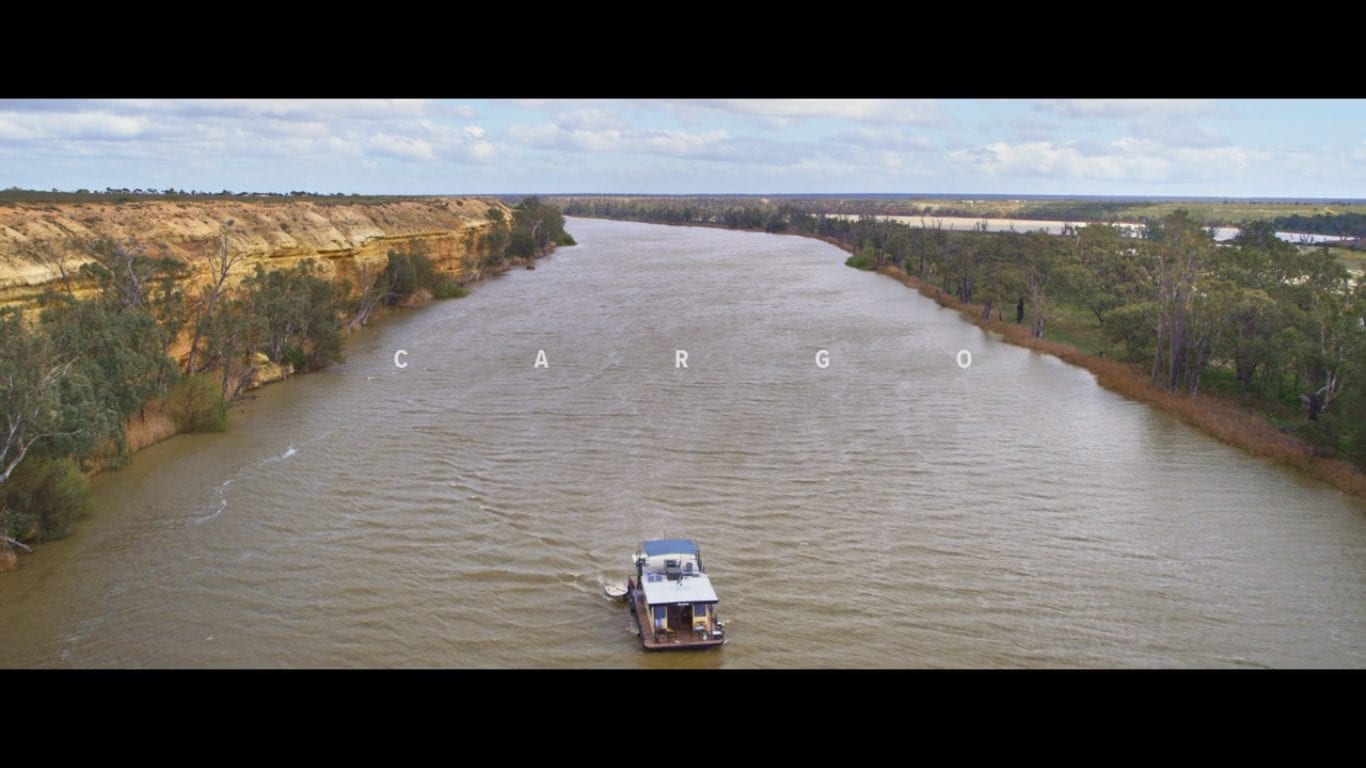
In recent years I have loved films like Maggie, The Girl with All the Gifts, and the four-part REC series. On TV, of course, there’s the immensely popular Walking Dead franchise, but I’ve particularly loved shows like iZombie, Santa Clarita Diet, and Les Revenants, which is the best zombie-related work of art I’ve ever seen. Like each of the films in George A. Romero’s six-part Dead series, Cargo is a movie that has something meaningfully rich and thematically intelligent to say. It’s a film that takes pride in its story and characters, limiting the scenes with blood and gore to the bare minimum required over its 105-minute runtime. Adapted from their own 2013 short film, co-directors Ben Howling and Yolanda Ramke waste no time in letting us know that this isn’t going to be a fun ride. It’s a desolate, unforgiving, joyless vision of a world emaciated by a virus that causes people to turn into zombies 48 hours after they’ve been infected. This isn’t a film for the eternal optimist. Really.
It’s bleak, dark, heartbreaking cinema. It’s a good job I’m a pessimistic, glass half empty kind of guy then, isn’t it? Cargo opens to some truly beautiful aerial footage of a child running through the deteriorating Australian outback and quickly introduces us to our main protagonist, Andy (Martin Freeman), who is travelling aboard a houseboat with his wife, Kay (Susie Porter), and their one-year-old daughter, Rosie. What’s immediately obvious is the earthy colour palette of the film – a murky, dying landscape filled with various shades of browns, greys and greens. Vibrant colour is used sparingly throughout the film, but its importance should not be understated. Very early on, we see a reddish/pink balloon floating off into the sky, which to me, signals the death of childlike innocence (after all, Andy and Kay’s daughter is called Rosie). Rosie may never see the beauty of the world, as she was born into this forsaken hell, unaware of what came before.
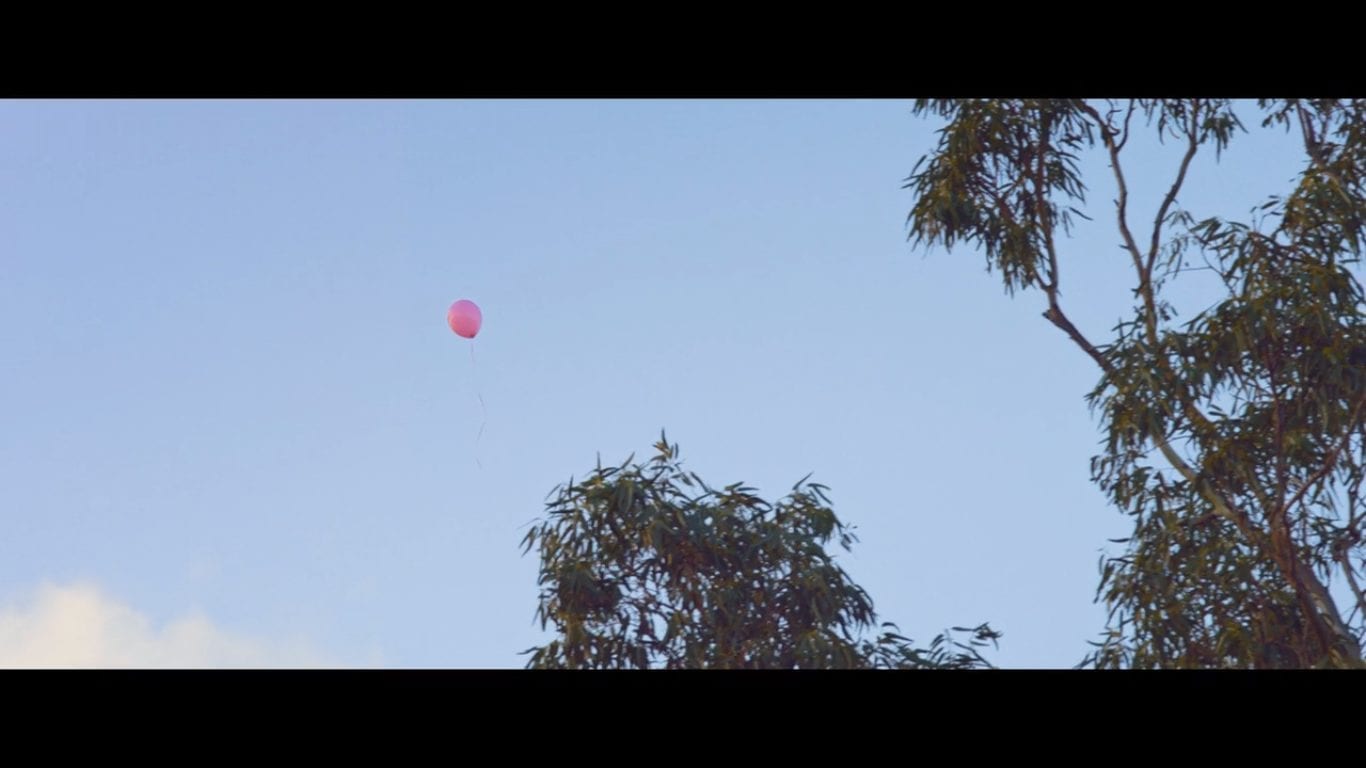
The reddish/pink balloon may also bring about memories of The Red Balloon or Stephen King’s It or even Twin Peaks: The Return, but I’ll leave you to decide if there’s any correlation. The balloon came from a family on land, but there’s no hope for a shared communal fight against this virus, as the father flashes his revolver to Andy, signalling him to continue on his journey. Kay thinks there’s a better chance of survival on land, but Andy would rather stay on the river, despite the depleting rations of food. Andy thinks he’s hit the jackpot when he happens upon an abandoned yacht full of useful items, but there’s something in there, moving, just out of sight. Unfortunately, Andy and Kay’s joy is short-lived after Kay gets attacked while searching the yacht on her own. This is where we’re introduced to Cargo‘s reinvention of the 48-hour cycle it takes for a human to turn into a zombie. It’s a great twist, which adds a sense of tension and foreboding doom to the mythology of the transformation.
From henceforth, all bets are off. Andy and Kay decide to move on land and narrowly escape a zombie attack while preparing an abandoned car. Unfortunately, Kay is deteriorating at a rapid pace and Andy accidentally crashes the car to avoid a zombie, impaling Kay in the process. The wound kills Kay, and she bites Andy’s arm upon her awakening as a zombie. One of the many great things about Cargo is the way in which it tells its story. The epidemic has clearly been around for quite a while, but the filmmakers trust us to be smart enough not to question how or why it happened. It simply did, and we’re watching a family in the middle of the crisis. The origin of the virus is unimportant. We are told only what we need to be told, and I love that approach. There’s a lot of really dumb, poorly written horror films out there, made as simple as possible to appease an audience on mass. Cargo trusts that you’ve seen those films and are looking for something more than the usual course of action.

Of course, with Kay now dead and out of the picture, where does this leave Andy and Rosie’s chance of survival? Obviously, the baby adds a sense of jeopardy to the narrative, but the father-daughter relationship as portrayed on-screen is much more than just a plot device. With act one over, this is where the real film begins: watching Andy do everything he can to protect his daughter and secure her survival in the remaining 48 hours of his life. Cargo has been compared to John Hillcoat’s 2009 film adaptation of The Road by a number of critics, and they’re not wrong. It’s an obvious comparison, but an appropriate comparison nevertheless. At their core, both are bleak, post-apocalyptic tales of a man’s struggle to protect his child under viciously challenging circumstances. Like I said earlier, Cargo is not a film for the eternal optimist. At the end of the day, much like Viggo Mortensen’s character in The Road, Andy is powerless to the brutally antagonistic landscape in Cargo, but Rosie’s survival is key.
Throughout the rest of the film, Andy crosses paths with a number of characters, not all of whom are what they seem. First, he meets Etta (Kris McQuade), a former teacher who never left the school at which she once taught. Etta cleans Andy’s wounds and tells him that all her students left to live in the old ways, “The whole community [Aboriginals] up and left back to their country.” One of the Aboriginals, Thoomi (Simone Landers), has popped up on a number of occasions so far during the film, and her importance to the plot will become greater later on. The next morning, Etta tells Andy to find Thoomi’s father, Willie (Bruce R. Carter), but Andy already knows Willie has turned after seeing him the day before. A striking image that continuously reappears in Cargo is that of dead people, whose heads are buried beneath the sand. My theory on this image relates to the next character we meet, Vic (Anthony Hayes). Smart horror fans will know not to trust a guy like Vic. Never trust a guy like Vic.
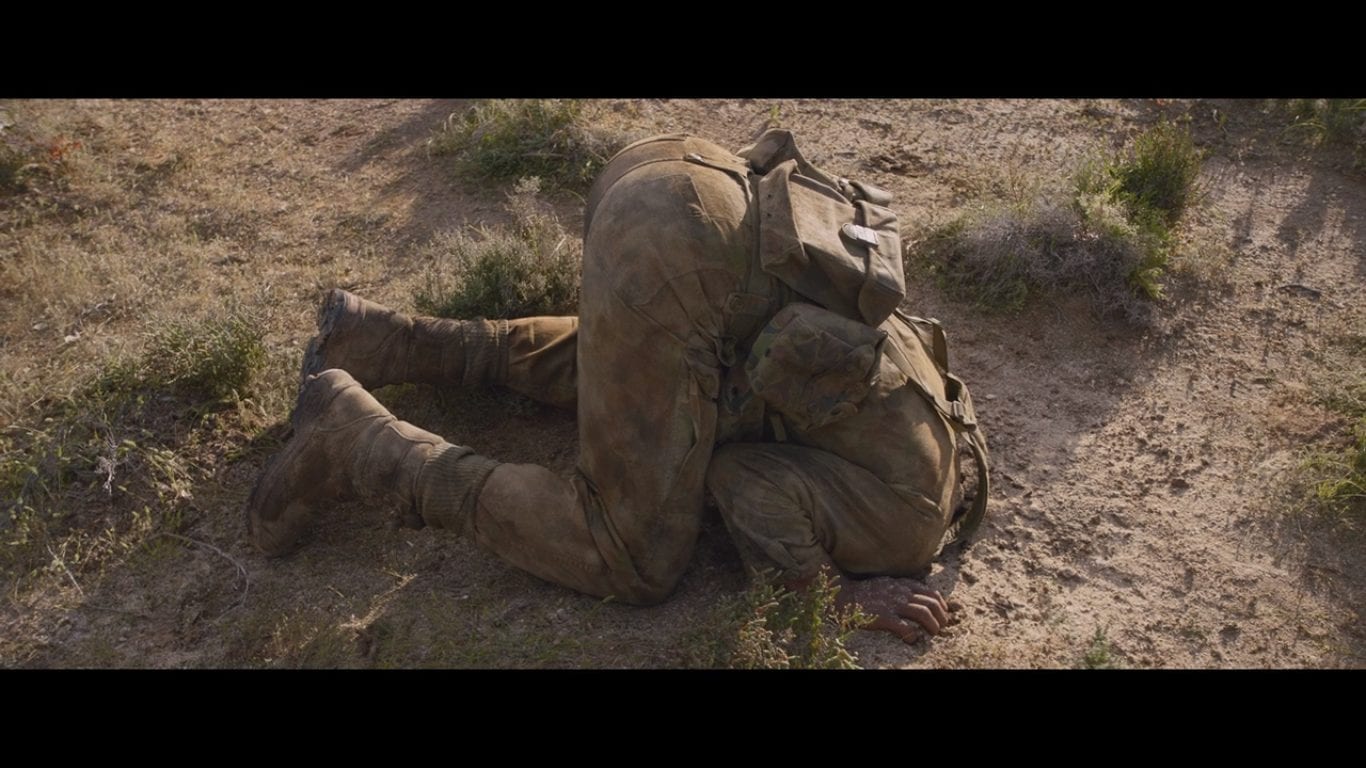
After stopping to give Rosie some water, Andy hears gunshots and finds Vic, who is trapped in a ditch. Vic shoots and kills a zombie, saving Andy in the process, and they drive off to meet Vic’s wife, Lorraine (Caren Pistorius). At first sight, all seems well and good, but as you know, the undead in zombie cinema is never the real monsters of which we should be afraid. Soon after, Andy is made aware that Vic has captured Thoomi and is using her and others as bait to lure zombies into his traps. It’s also later revealed that Lorraine is being forced to act as his “wife” after he let her actual husband die so he could save his own life. A character like Vic is the embodiment of the controlling, privileged white man, using his power to abuse those he considers to be lesser than himself. Even in a post-apocalyptic setting, the dehumanisation of a civilisation is still very apparent and sickeningly horrific.
You see the image above of the man with his head buried in the sand? Maybe it’s a metaphor for how the powerful, abusive white men of this world would rather bury their heads in the sand, instead of acknowledging the centuries of sins from which they’ve benefited. As a white man and as a pessimist, it’s extremely hard to watch a film like Cargo and not relate it to our current political climate. I wish we lived in a better world, free of racism and discrimination, but when you see the leader of the free world acting the way he does on a daily basis, it doesn’t take too long to realise that the world hasn’t changed as much as it should’ve in the years since the various civil rights movements across the globe. Vic is an abhorrent piece of work, enslaving the Aboriginals in cages, taunting them over what he believes should be his, “I told you mob. The wells are mine along with what’s in ’em. F**k with me and I’ll f**k with you.” Vic and Andy are thematic opposites. The duality of man. Yin and yang, if you like.
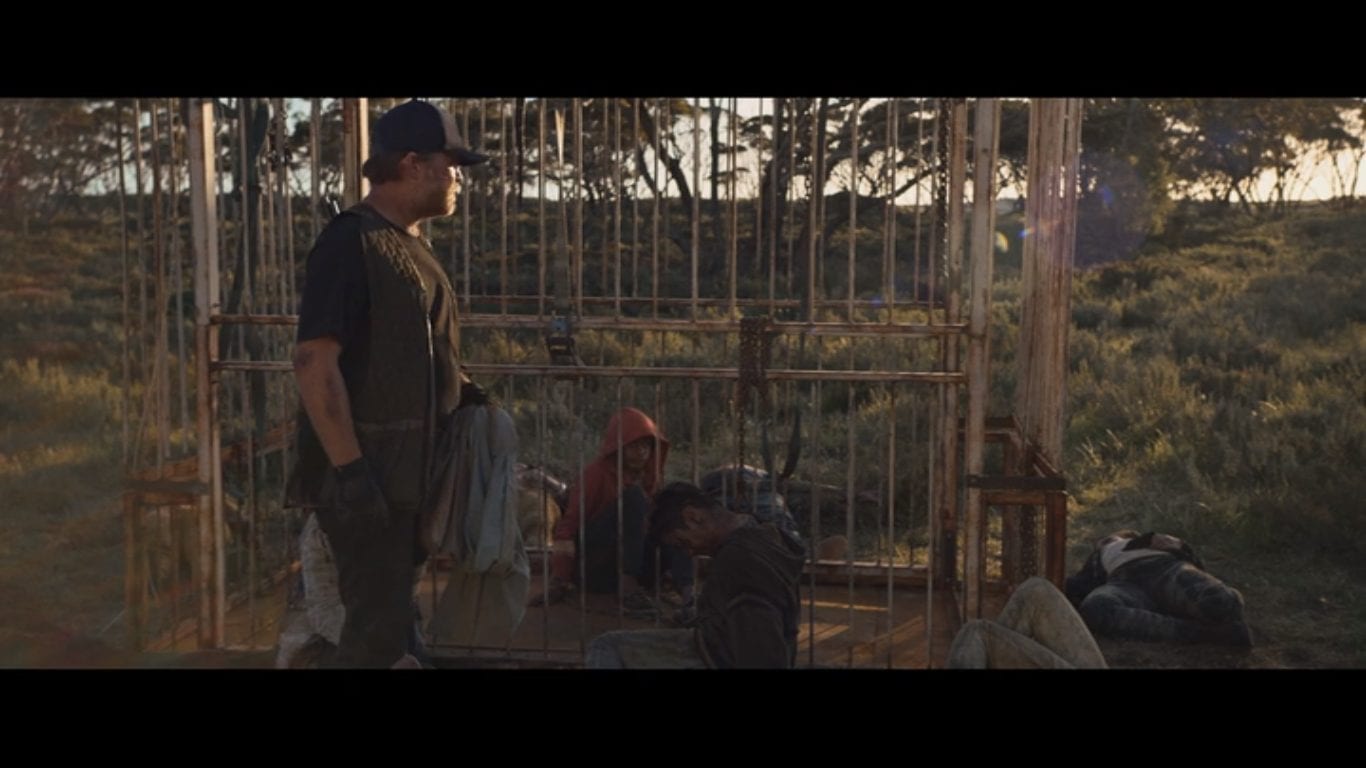
Naturally, Andy is horrified by Vic’s actions and later finds himself locked in a cage alongside Thoomi. The zombies are never the real monsters, are they? Well, maybe they are in lesser films with nothing to say, but in films like Cargo and the works of Romero, they’re often a metaphor for the complex human condition and the evil that men do. Luckily, Andy and Thoomi manage to escape the cage and go to find Lorraine and Rosie. Lorraine sacrifices herself to aid their escape, but Vic follows in pursuit. After narrowly avoiding Vic’s wrath, Thoomi, Andy and Rosie go in search of the “Clever Man.” While on the journey, Thoomi sees her father, now completely dead, ending any hope of him returning to his human state. Hours later, they find the family seen at the beginning of the film, but they’ve reached them too late. What follows happens off-screen, but its impact is no less distressing. Three gunshots are heard, and the father kills himself just out of focus. The sound alone is disturbingly chilling.
After, they stumble upon Vic in a train tunnel, and a fight breaks out between him and Andy. Both men take a bullet to the upper body, and Vic nearly kills Thoomi with brute force. Andy manages to save Thoomi and Rosie, but his time is nearly up. He’s beginning to turn, struggling to hide his impulses, weakening by the minute. Andy’s final seconds alive absolutely broke my heart. I’m more than comfortable to admit that I’m an emotional guy, and I definitely had a lump in my throat during the scene. We see the final moments of humanity fade from Andy’s eyes, as Thoomi sprays his wife’s perfume in the air, letting him die with love in his heart. The score, too, heightens the emotion with its beautifully soft and delicate arrangement. In that moment, which also sees the arrival of Thoomi’s family, the film reaches its natural conclusion. Rosie has survived, safe in the care of Thoomi and the Aboriginal people. There is no prejudice. Just love and acceptance by everyone in the community.
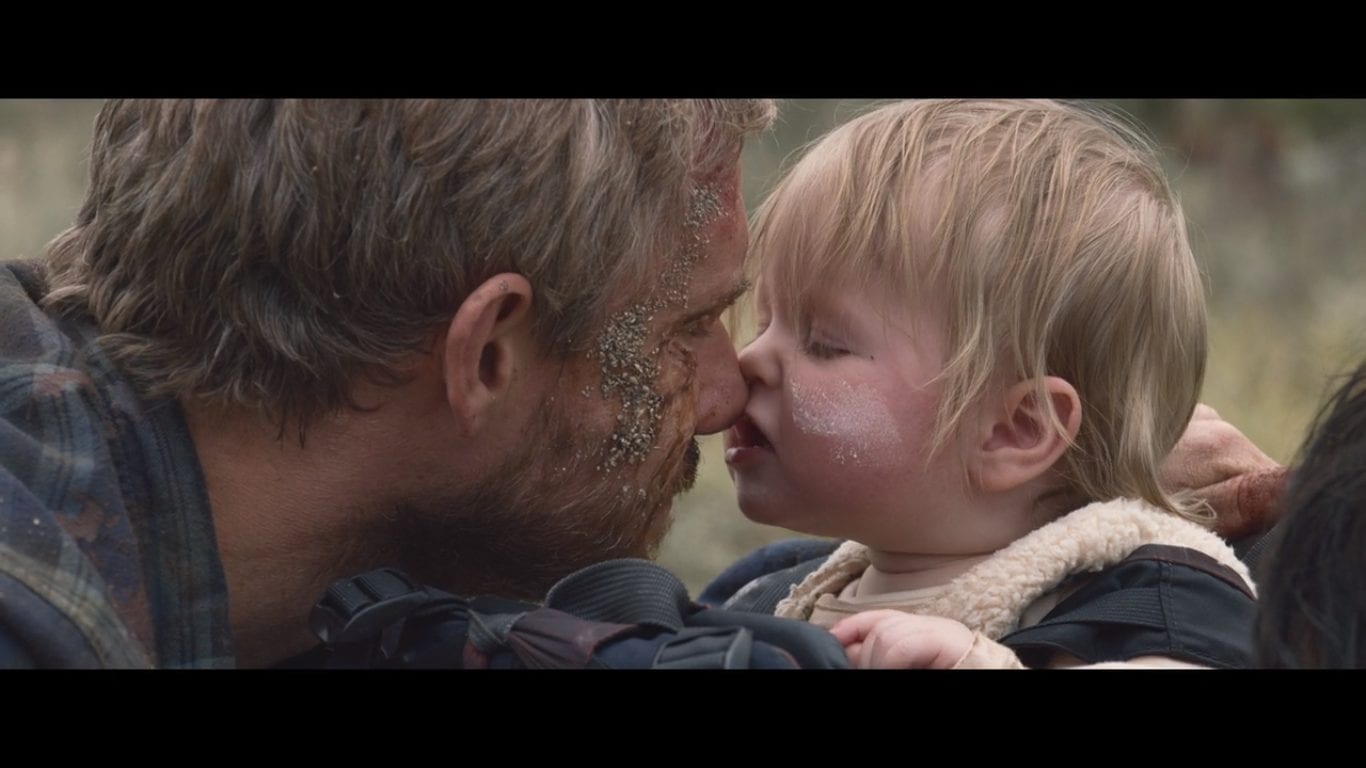
Something I’ve yet to mention is the stunning cinematography by Geoffrey Simpson, who perfectly captures the bleak and despairing vision created by Ben Howling and Yolanda Ramke. This isn’t a flashy, Hollywood-style zombie film, as Simpson photographs the Australian outback in all its isolated glory. Of course, the cinematography will remind people – particularly an international audience – of films like Mad Max and Wolf Creek, but Cargo‘s tone and its story has as much in common with Walkabout as it does anything else. And, it’d be amiss not to mention the brilliant performances from the entire cast, led by a never-better Martin Freeman. Freeman is simply one of the greatest everyman actors on the planet. You believe his relationship with Rosie and Thoomi implicitly. Whether it’s The Office or the first and best season of Fargo, Freeman always draws you in with his undeniably natural style. He never looks like he’s acting, and perhaps there’s no better compliment to give an actor.
Cargo is the best film I’ve seen so far this year. It doesn’t matter whether it premieres in the cinema or on Netflix, because a great film should always be recognised as a great film, regardless of its nature. The tragically haunting narrative of Cargo moved me in a way I never expected and made me think about the world today as we know it. Netflix is infamous for never releasing the stats of its audience share, but I hope Cargo has been a success for them. I think they’re doing brilliant work, bringing smaller films to a mass audience that might have been lost among the blockbusters had it been released in cinemas. And better yet, you don’t have to deal with the annoyance of a nachos-crunching, carelessly obnoxious audience. Just click that Netflix button on your remote control, and delve into their great, ever-expanding library of original films. Hell, if Netflix keeps on putting out films as good as Cargo, I might never need to go to the cinema again.
What are your thoughts on Cargo, and the state of the modern zombie subgenre in general? Are you feeling the supposed fatigue that has set in over the past few years, or is there still enough being done with the genre to keep you coming back for more? Please leave a comment and let us know by following the information about our social media accounts, which can be found below. Alternatively, you can follow me on Twitter (@JonSheasby), and we’ll continue the conversation over there.



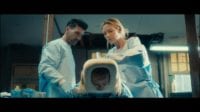
One Comment
Leave a Reply